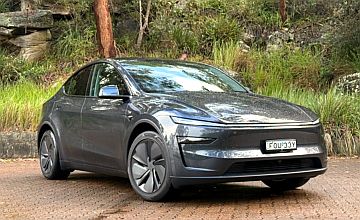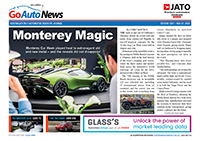Make / Model Search
OptionsCar reviews - Tesla - Model YTesla modelsOverviewWe like Substantially improved ride quality, quieter cabin, outstanding as-tested efficiency, practical real-world range, spacious packaging, comfortable cooled seats, respectable value for money Room for improvement Short vehicle warranty, overly quick steering, middling wet grip, occasional camera-driven safety system glitches, conservative traction control, arguably lacks budget and extra-large battery grades Latest Model Y nails the brief on efficiency and real-world range8 Apr 2025 By TOM BAKER Overview
CONTRADICTORY as it may seem, given the conservative tone of the contemporary political causes preoccupying chief executive Elon Musk, American electric vehicle (EV) specialist Tesla has arguably done more than any other manufacturer to entrench battery EVs as a permanent fixture of the automotive landscape – both in Australia and globally.
Since Tesla launched in Australia in 2014, a limited number of relevant models have been bolstered by access to the extensive (and generally reliable) Supercharger network, which until recently was exclusive to Tesla owners. The timely arrival of the Model Y in June 2022 – into Australia’s highest-volume segment, midsize SUVs – only added fuel to the brand’s local momentum.
The Model Y was a right-sized EV that arrived in Australia at just the right moment. Buyers tempted by full electrification often found themselves unexpectedly cashed-up thanks to pandemic-era economic support, while few rival brands had launched convincing alternatives. In 2023 and 2024, the Model Y became the world’s best-selling car; Tesla secured 28,769 local sales in 2023 and a further 21,253 in 2024.
All else being equal, the mid-life update to the Model Y might have secured a third consecutive year at the top of global sales charts – but the vehicle not codenamed ‘Juniper’ within Tesla headquarters launches into considerable headwinds, both external and internal. Mainstream buyers remain cool on EVs, while Tesla boss Elon Musk’s political leanings will not align with all customers.
Australia is among the first global markets to receive the updated Model Y, best described as a heavy facelift of the original vehicle. Minor dimensional changes (+41mm in length, -5mm in ground clearance) disguise substantial hardware substitution – around 50 per cent of parts are new. More visually apparent is the industrial design, now drawing clear inspiration from the Cybertruck. As before, Australian-market Model Ys are sourced from Shanghai, China.
Battery capacities remain unchanged, but the updated Model Y offers more generous specification. Entry pricing has risen by $3000, now starting at $58,900 before on-road costs for the Rear-Wheel Drive (RWD) base variant, which uses a 60.0kWh usable battery claiming 466km of WLTP range. The Long Range All-Wheel Drive (LRAWD) has been reduced by $1000 to $68,900 BOCS, retaining its 75.0kWh pack with a 551km WLTP range claim.
Both variants receive substantial hardware upgrades, including frequency-selective dampers and additional cabin insulation. Also new are a front-facing camera, pixel LED headlights, front and rear light bars, adjustable regenerative braking, silver-layer insulated glass for the roof, redesigned front seats with cooling (in addition to heating), an 8.0-inch rear display, and a larger 15.4-inch central touchscreen.
Most Australian buyers will find the 255kW/450Nm single-motor RWD variant more than sufficient. Beyond the new additions, the RWD comes equipped with 19-inch ‘Crossflow’ alloy wheels wrapped in 255/45 R19 Hankook Ventus S1 Evo tyres, LED taillights, 12-way power-adjustable front seats, a heated steering wheel and rear seats, a nine-speaker audio system, twin wireless device chargers, surround-view cameras and a feature-rich smartphone app for remote functions.
The $10,000 step up to the 378kW/493Nm LRAWD primarily secures, as its name suggests, the added surety of all-wheel drive and an extra 85km of range over the RWD (equating to $117 per additional kilometre). Buyers also benefit from a more substantial 123kW and 43Nm increase in outputs—along with an excellent 16-speaker premium sound system that, for some, will justify the upgrade alone.
A refreshed Performance flagship is expected to be unveiled soon.
Optional extras include paint (Pearl White is standard; Glacier Blue and Stealth Grey cost $2300; Quicksilver and Ultra Red attract a $2600 premium), 20-inch ‘Helix’ wheels (+$2400), and a white interior (+$1500). Enhanced Autopilot (+$5100) and Tesla’s so-called Full Self-Driving Capability (+$10,100) are also available, though both remain subject to Australian regulatory approval and therefore offer strictly limited functionality.
Battery chemistry also differs between variants. The Australian-spec RWD uses a 60.0kWh (usable) lithium iron phosphate (LFP) pack, sourced from BYD. As with other LFP batteries, it is recommended to charge the RWD to 100 per cent regularly. The LRAWD’s 75.0kWh nickel manganese cobalt (NMC) pack, however, should typically be limited to 80 per cent – except during road trips.
Claimed efficiency is impressive (12.8kWh/100km for the RWD and 13.6kWh/100km for the LRAWD) but charging performance is average for the segment. Both variants support 11kW AC charging. While the LRAWD’s NMC battery can reach higher DC peak speeds (250kW versus 175kW), average highway top-ups from 10 to 80 per cent are similar: the RWD charges at an average 110kW over 24 minutes to regain 326km, while the LRAWD averages 124kW over 27 minutes to recoup 385km.
In a stark reversal from the Model Y’s initial launch, direct rivals are now numerous. Prices range from the Leapmotor C10 (from $45,888 BOC) to the BMW iX3 (from $91,000 BOC), with competitors including the Audi Q4, BYD Sealion 7, Cupra Tavascan, Deepal S07, Ford Mustang Mach-E, Hyundai Ioniq 5, Kia EV5 and EV6, Skoda Enyaq, Subaru Solterra, Toyota bZ4X, Volkswagen ID.4 and XPeng G6.
Yet despite most rivals offering at least five years of warranty coverage – if not more – the Tesla Model Y continues to stand out for its limited four-year/80,000km vehicle warranty. The battery and drive unit are at least covered for eight years/160,000km (RWD) or 192,000km (LRAWD), with pack capacity guaranteed to retain at least 70 per cent of original health.
Driving Impressions
Tesla has long positioned the Model Y’s features, specifications and price squarely in the middle of the midsize SUV segment. Its runaway global success supports the idea that it’s a true mid-market offering – which makes it all the more surprising that the Model Y’s dynamic character is quite overtly sporty, rather than bland or inconspicuous.
In fact, the suspension calibration of the original Model Y (even after a hasty ‘comfort’ suspension upgrade in late 2022) saw its tuning needle set so far towards firmness and control that the experience as a driver or passenger was characterised by uncouth ride quality across poorly surfaced Australian roads.
Green shoots appeared with the Australian release of the mid-life upgrade of the Model Y’s sibling model, the Model 3 sedan, in 2024. While the lower-set Model 3’s suspension was never as compromised as the pre-facelift Model Y, last year’s ‘Highland’ update to the former model involved a worthwhile switch to capable frequency selective dampers, noticeably improving that car’s bandwidth.
Headlining mid-life alterations to the Model Y’s hardware are the substitution of fully passive dampers for the same frequency-selective tech enjoyed by the Model 3 (as well as rivals like the Ioniq 5 and EV6—they are not a Tesla exclusive). It is worth noting that simply swapping in a new damper rarely fixes ride on its own; correct geometry and a deft tuning touch are also required.
Thankfully, for buyers and for those who ride in Model Ys via Uber, et al, those ingredients have combined to deliver a marked improvement in ride quality. A firm edge and more pronounced road feel remain compared to most rivals, but impact compliance is noticeably improved. The updated Model Y quite literally ‘takes the edge off’; in short, it’s a more mature vehicle in every respect.
Improvements extend to overall refinement. The outgoing Model Y wasn’t just bumpy, it was also noisy, with overdamped suspension booming into an echoey cabin. Tesla claims a 20 per cent reduction in such noises, though we suspect the improvement may be even greater. A previously frustrating rear-end resonance also appears to have been eliminated.
Correcting the Model Y’s control–compliance balance has not come at the expense of agility. A back-to-back test of old and new on a closed course revealed that the ultra-firm, flat-cornering pre-facelift Model Y retains a slight edge in some bends. However, the more measured tuning of the updated version still enables brisk progress. To our tastes, the steering remains overly frenetic (and largely devoid of feel), while conservative traction control dulls engagement during zealous cornering.
Our Long Range tester’s sensible 19-inch wheels almost certainly contribute to its composed dynamics, while the 255/45 Hankook tyres proved a fine match in dry conditions – though wet grip was merely average. In damp weather, we noticed a tendency for the car to skip over bumps under braking and a reduction in front-end suspension travel during deceleration was noticeable.
Like most of its EV rivals, the Model Y, regardless of variant, delivers brisk, seamless acceleration off the line, as expected from an electric drivetrain. For buyers moving from a combustion or hybrid vehicle, the refinement and performance will come as a welcome surprise. Those familiar with other EVs will appreciate the precise throttle pedal calibration, and now, the brake pedal feel is similarly well-tuned.
Despite Tesla’s advocacy for one-pedal driving, the updated Model Y now includes a new ‘Reduced’ regenerative braking mode, clearly benefitting from bespoke tuning, because it works exceptionally well. While many EV drivers prefer a full one-pedal setup, we don’t (despite owning an EV); the natural engine braking feel, combined with the well-weighted brake pedal in Reduced mode, suited our preferences perfectly.
As expected, the LRAWD is quicker than the RWD – despite weighing more (1992kg vs 1921kg) –thanks to its extra grunt. The RWD accelerates from 0–100km/h in a claimed 5.9 seconds, while the LRAWD completes the sprint in 4.8 seconds. A paid Performance Boost is available to shave that to 4.3 seconds, though pricing for the upgrade is yet to be confirmed.
In addition to being noticeably quieter on the move, the Model Y’s cabin benefits from several thoughtful updates following its mid-life refresh, starting with significantly improved front seats. Previously soft and unsupportive, they’ve been replaced by firmer, more ergonomic chairs featuring effective sweat-wicking ventilation (alongside heating) to counter the thermal downsides of vinyl trim.
Forward and lateral visibility from the relatively high-set, 12-way power-adjustable front seats remains excellent, thanks to the Model Y’s expansive ‘fishbowl’ cabin design. However, the rear window’s narrow aperture still hampers rearward visibility. Standard blind-spot cameras, displayed via the slightly enlarged 15.4-inch touchscreen, help ease lane changes.
The touchscreen has received user interface improvements over the years, and Tesla’s in-built software performs well. Navigation and apps for Spotify, Apple Music and podcast platforms highlight the clarity and power of the LRAWD’s 16-speaker sound system. However, there’s no support for Waze, Apple CarPlay or Android Auto, nor is there a traditional instrument cluster or head-up display.
Rear seat passengers also benefit from a subtly reshaped and lengthened bench, although the shallow thigh angle still limits support for taller occupants. Plush materials carry over from the first row to the second, and a new 8.0-inch centre-mounted rear screen allows access to Netflix and games, though most passengers will prefer the ergonomics of using their own devices.
A power tailgate now opens automatically when a Tesla app-equipped smartphone is detected nearby, thanks to the addition of ultra-wideband Bluetooth. The resulting cargo space is generous, Tesla appears to measure the 854 litres to the roof, unlike most other manufacturers—though there is impressive underfloor storage. Up front, a sealed 117-litre frunk with a new drain hole adds further practicality.
Unlike most other cars on sale, the Model Y’s adaptive safety systems rely solely on its nine onboard cameras, there’s no radar or lidar. For the most part, they work well, with a level of tuning sophistication often lacking in both new and established brands. On test, the adaptive cruise control and lane-keeping systems performed well, aside from a few notable exceptions, where harsh contrast between sun and shadow confused the front-facing camera.
Setting aside the political backdrop, the other elephant in the room is Tesla’s so-called Full Self-Driving (FSD) feature. At $10,100, it’s a costly option that could represent groundbreaking technology, if fully realised and approved for use in Australia. As it stands, neither milestone has been reached, and most buyers will find the standard tech suite, and five-star ANCAP rating, more than sufficient.
We haven’t yet tested the refreshed Model Y RWD, but we were impressed by the real-world energy consumption of the LRAWD. Despite its performance and varied test conditions, from stop-start traffic to 110km/h freeway cruising, the dual-motor Model Y returned 13.8kWh/100km, equating to a range of 543km, falling just two per cent shy of the WLTP claim.
The rise of more affordable, price-leading electric crossovers, many from China, has arguably created space for Tesla to position the Model Y more comfortably as a semi-premium SUV. And in updated form, that’s exactly what it feels like: a more complete and resolved offering.
This SUV nails the brief on efficiency and real-world range while providing a more measured and mature daily driving experience characterised by noticeably less frenetic ride quality, which makes it a bit of a shame that the Model Y has, for better or worse, been transformed into a bold political statement, at least for the time being.
 Read moreAll car reviews Alfa Romeo Alfa Romeo Abarth Abarth Audi Audi Aston Martin Aston Martin BMW BMW Bentley Bentley Chrysler Chrysler Chevrolet Chevrolet Dodge Dodge Citroen Citroen Ferrari Ferrari DS DS Ford Ford Fiat Fiat FPV FPV Foton Foton Haval Haval Great Wall Great Wall Honda Honda Holden Holden Hyundai Hyundai HSV HSV Isuzu Isuzu Infiniti Infiniti Jaguar Jaguar Iveco Iveco Kia Kia Jeep Jeep Land Rover Land Rover Lamborghini Lamborghini Maserati Maserati Lexus Lexus McLaren McLaren Mazda Mazda Mercedes-Benz Mercedes-Benz Mitsubishi Mitsubishi Mini Mini Opel Opel Nissan Nissan Porsche Porsche Peugeot Peugeot Ram Ram Proton Proton Rolls-Royce Rolls-Royce Renault Renault Skoda Skoda Saab Saab SsangYong SsangYong Smart Smart Suzuki Suzuki Subaru Subaru Toyota Toyota Tesla Tesla Volvo Volvo |
OptionsClick to share
|











Facebook Twitter Instagram